
Congratulations to everyone who participated in the first ever VisionDevCamp — the world’s largest gathering of Apple Vision Pro developers and devices in history! Over 120 people (more than 56 Apple Vision Pro devices — pictured above) came together in Santa Clara, CA from March 29-31, 2024.
By the way, there were another 20 or so devices that didn’t make it into the photo — check out the gallery. We had an amazing weekend:
- 48 hours of cooperation
- 36 demonstrations
- 27 winning teams (and a notable runner-up)
- 24 mentors

The people pictured above were recognized by the participants awarding them blue tickets after they offered assistance — many of them multiple times. Our most sacred value is helping others. This is how we get the best results and have become the most successful hackathon in the world. Our 17 year tradition is going strong and this year we had the greatest ratio of participants-to-demonstrations ever for an event: 7:2.
It’s who we are and how we work together that matters. The results speak for themselves.
The Champions
Hardest Fail
Unreal Engine on AVP

Andreas Jaensch flew himself in from Germany. He arrived early to the event. He hacked all weekend to try and get Unreal Engine to work on Apple Vision Pro — but it wouldn’t compile. Instead, he got onstage and talked about what he learned. He embraced the situation and showed us a video of someone else who had just gotten it working hours earlier and posted online.
Now THAT is humility. That is grace. And we all learned something in the process.
It happens every event that someone tries and tries and tries but just can’t make it work. Andreas threw himself into a super difficult, bleeding edge technology — and for that we honor him.
Best Developer Tool / Open Source
ARKitVision

There were many great projects that went Open Source over the weekend — but John Haney produced the most useful piece of all, including two template projects:
Common Space is a template project which will go into an immersive space looking for an image anchor.
- The scene will have a homeEntity added, and if the image anchor is found, the homeEntity will be anchored to it’s location
- Then you can add content relative to the homeEntity or just use it for converting transforms relative to the homeEntity
- This will create a common coordinate system you could use to share between devices visiting the same location
SimpleARKitVision provides a code wrapper around setting up an immersive space to be able to take advantage of the various detectors and providers available in ARKit in visionOS. It includes:
- Hand Tracking
- Plane Detection
- Scene Reconstruction
- World tracking
- Image tracking
View the repository on GitHub. Thanks, John!
Best Hardware
RearViewsion Camera

David J. Kordsmeier built a working rear-view camera for Apple Vision Pro — that streams live to your space. It’s a sensor fusion app, based on an ESP32-EYE, and grabs image frames into a floating window. This allows the user in VR to see if someone is walking up on them from behind. The device has face detection (and cat detection) as well so it is possible to add additional features like haptic alerts or notifications if certain things are detected.
It’s always impressive when someone creates working hardware at a software development event. Follow David’s Open Source project on GitHub.
Simplest App
Hand Puppet

Martin Bjerregaard Nielsen flew himself in from Denmark to learn and build something inspired by one of our champions — a virtual hand puppet. Sometimes the simplest ideas can win — because they are achievable in time.
One of the best bits of opening day advice from our Camp Counselor Eric Oesterle was, “Take your idea, then cut the scope in half. Then cut it in half again.” Martin pulled this off entirely by himself — then delighted the audience and judges with his presentation.
Yellow Ducky Award
Duck Chat

John Brewer started off the event with a challenge: take his 3D model of a rubber duck and allow two different Apple Vision Pro devices to see it and be able to point to a specific place on the duck at the same time. From that point on, a meme was born. Several teams incorporated the yellow ducky into their projects and he inspired us all to make collaborative experiences in a shared space.
For his own demonstration, he built chat service between two devices so that they could “quack” to each other. Thanks for making the event more fun and playful, John 🙂
Best Windowed App (2D Window)
Anagram Reality

Ian Baird and his twin daughters Ada and Grace teamed up to create a working game about solving anagrams getting hints — where you get cake as a reward. Not only was it a fun demo, but throughout the weekend we got to witness the spirit of the camp via this team.
Often we talk about how important it is to be inclusive and welcoming of everyone in the community. We make sure to schedule our event over the weekend, bring plenty of food and full meals, and personally advise teams so that they feel empowered to simply try. Anagram Reality is why we do it this way.
Grace was onstage with me when she had just turned four (4) years old at iOSDevCamp 2014:

It’s touching to see families hacking together — and wonderful to see them winning again and again.
Coolest App
Deep Muse

Warren Stringer is another original iPhoneDevCamp alum and prior champion. Not only did he get his app working in visionOS, he built his visualizer so that he could program the experience from another device — iPhone or iPad. From his description:
“Conduct visual music performances with your hands in a full immersive space. Play with your family and friends in real time, where their iPad and iPhone becomes window on that shared stage. Co-pilot a newbie’s experience in the VisionPro on your iPhone. Or: play along with an Apple Pencil or MIDI musical instrument. The possible ways to perform together are only limited by your imagination.”
Warren made the audience gasp and clap and made us all want to try it.
Best Volumes App (Bounded Volume)
Tumble Match
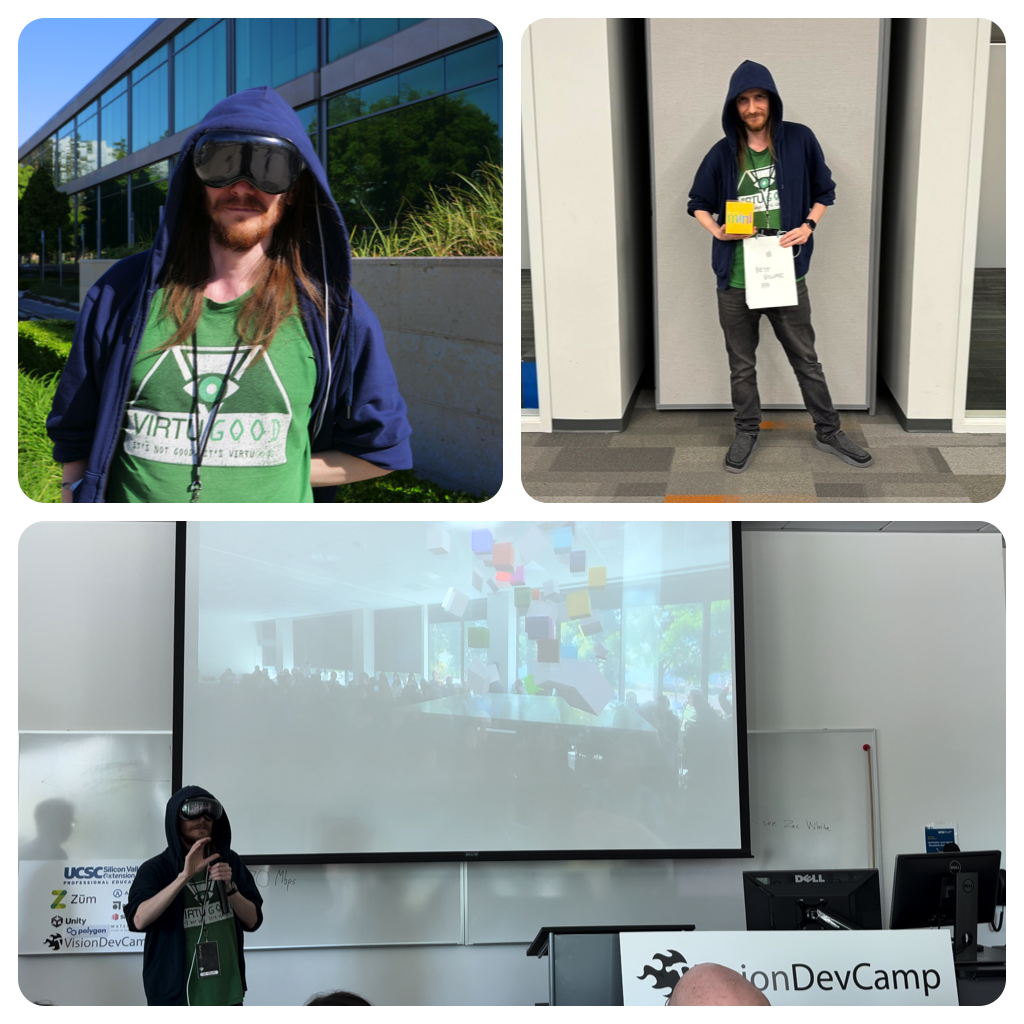
Tim Judkins built a game by himself over the weekend — another act of incredible accomplishment on site. It’s a matching game using a RealityKit volume and physics-based object manipulation. The risky part was demonstrating this live on stage — and it worked. Tim heard about us from the Voices of VR podcast, took a chance and simply crushed it. Can’t wait to see this one in the store.
Best New Developer
Spark

At every event, we have people who are new to the platform, new to the language, or new to the community. It takes tremendous guts and fortitude to progress under pressure, not to mention teamwork and a growth mindset. This was Jeffrey Brown‘s and Jennifer Jiang‘s first time using Swift or Xcode — and they made a beautiful flame appear in visionOS using a snap of their fingers. Impressive! Not only that, but they had a bonus “one more thing” to show us which was a “happy beam” of flame shooting out of the finger.
Magic is real, folks I’m telling you.
Best Storytelling
Huldufolk

“Did you know there are huldufólk, or hidden beings, right here in Silicon Valley? You only need to open your third eye to see them. Go outside and put on your Vision Pro, and if you’re worthy, you will find these huldufólk hidden in nature. And perhaps together, we can foster a better relationship between humans and nature.”
Dane Christensen and Barna Szász teamed up to captivate the audience with their working demonstration of this unique concept. Not only did they build their app around a fun and engaging narrative, they also provided us with a lesson on conserving nature and protecting our environment. Check out their amazing video recap of the event.

Sam Mateosian and Victor Arroyo joined forces to bring CyberSpace Sam to visionOS. It featured a “walking, smart-talking avatar” powered by speech recognition and machine learning. This live demonstration allowed the team to take questions from the audience for Sam, all the while showing us the network and API calls running in real time. Super impressive, fully featured, funny and wild!
Best WebXR App
Chem Reality
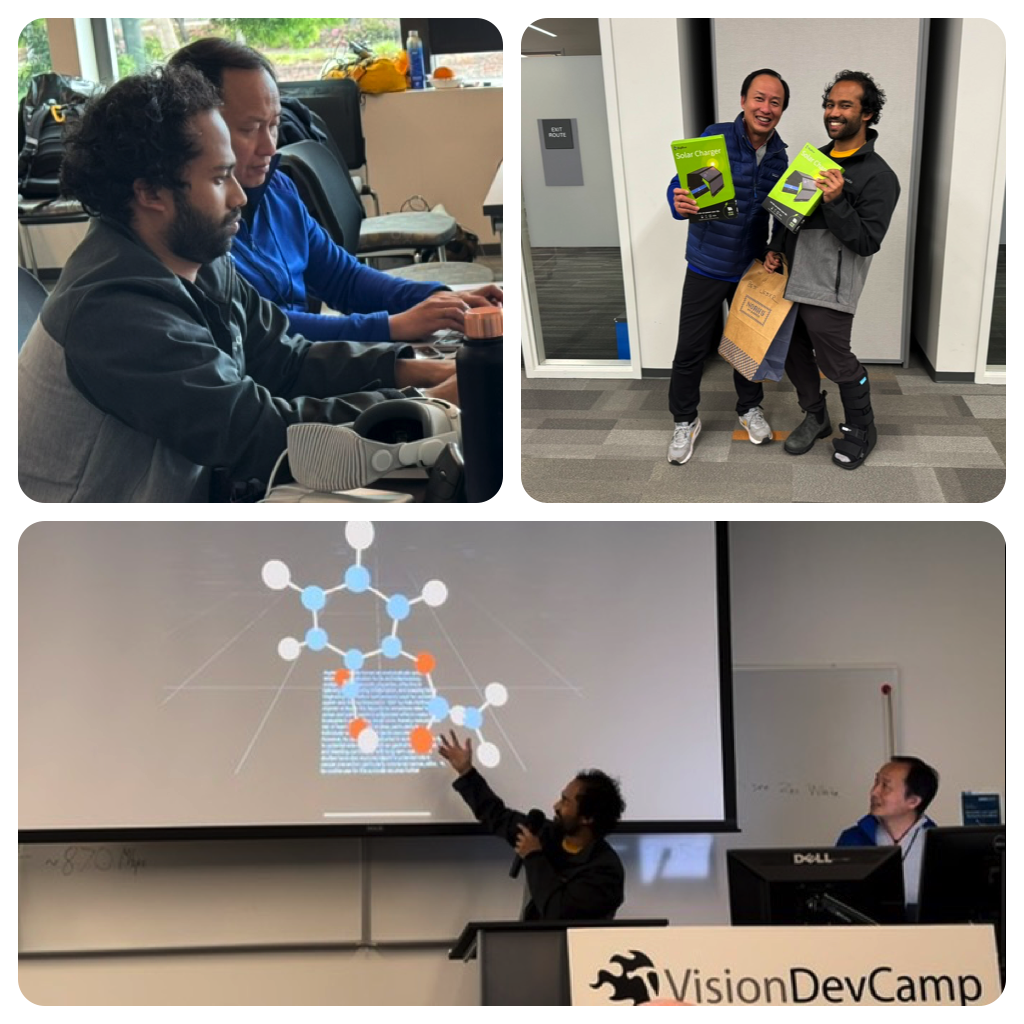
UC Santa Cruz PhD student Samir Ghosh met Kenneth Ng on site, teaming up to produce an experience that works across every platform. This app provides an educational experience that allows us to view the 3D structure of molecules, with descriptions powered by machine learning.
One of the founding principles of our community is the empowerment of Web technologies. This team once again proves that the constraint of the browser breeds creativity — and brilliance.
Most Motivational
Speak to Your Heroes
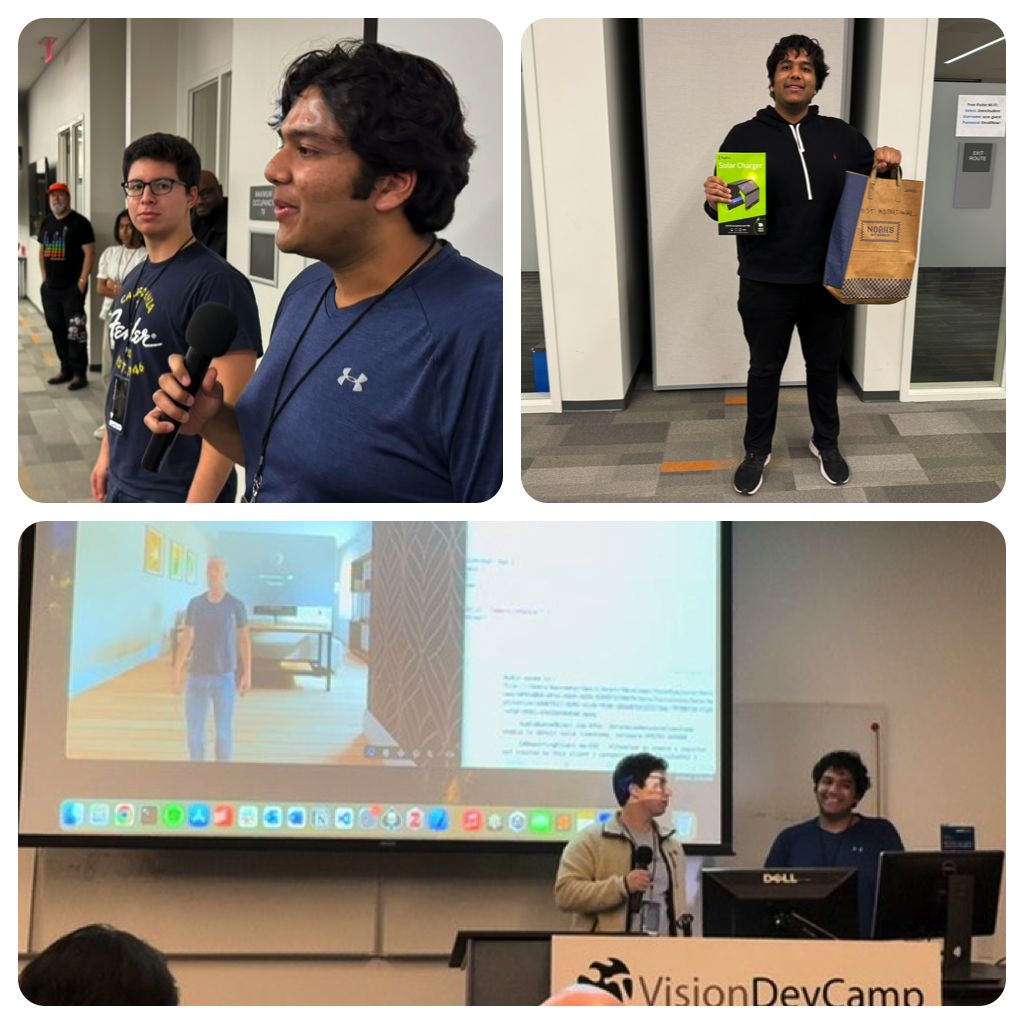
Yash Narayan and his Stanford classmate Darrow Hartman are no strangers to the hackathon circuit. In fact, they are organizers themselves. So it was no surprise that they pulled together an impressive, working demonstration of 3D modeling, avatar animation, text-to-speech combined with machine learning to bring comedian Robin Williams back to life for a brief moment in time.
It’s always cool to see presenters who engage with the audience as part of their demonstration. In this case, we all had the chance to play with their prompt and ask questions of the team.
Productivity Award
Time Cake
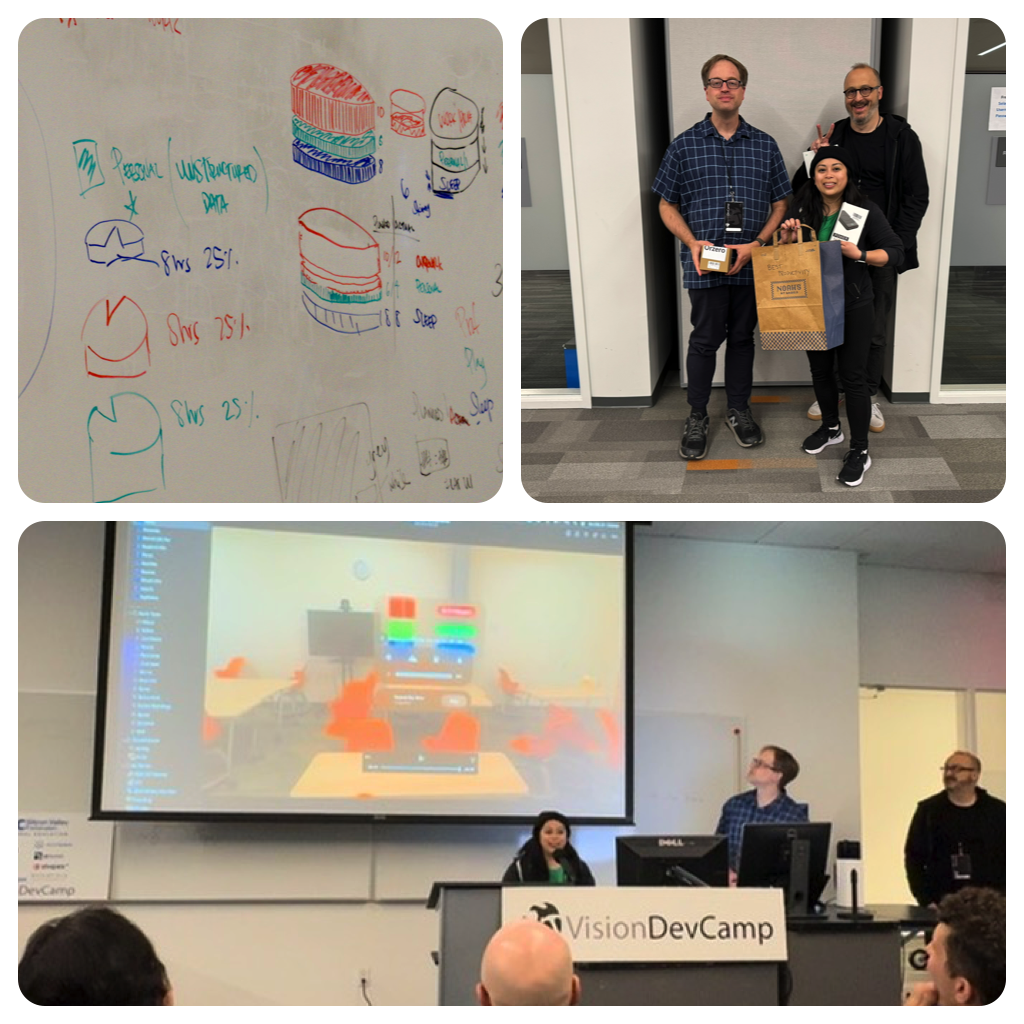
Erin Pangilinan, Andre Cunha and Steven Pease teamed up, designed and debated features and delivered a working app that helps keep the user on time and on task. Using the “cake” visual metaphor, this app shows time spent on various tasks and personal goals.
They explained their thought process while showing us the results. This stuff isn’t easy! It takes a combination of skills and discipline to make a spatial computing app in one weekend — and this team made the most of their time.
Best Design
Little Spatial Garden

“This app allows us to assemble a little virtual garden through Apple Vision Pro. Little Spatial Garden explores concepts of sandboxing and flower arrangements. Learn about flowers, create arrangements, and share to purchase these arrangements from local florists.”
The team of Paolo Villanueva, Yelena Kozlova and Kate Chen built an absolutely beautiful experience, a compelling and artistic demo and a lovely design that felt like crisp air during our contest. This is another app that is destined for many downloads.
Most Persistent
Navigation Exploration

Romy Ilano, Raymond Chen and Jayson McCauliff iterated over many ideas to consider the best experience when transitioning from one area to the next in spatial computing. At first it would seem obvious: just open a portal and step through it. But that could create disorientation or even nausea, given the rich visual stimulus of Apple Vision Pro.
Instead the team explored shimmering, luminous transitions, walls that come and go, and entire environments that shift and move. In this way, space becomes art and movement becomes shapeshifting and meaningful. We gave this award because the team took time to explain their thought process and efforts to reduce dysphoria. This work could be applicable to everything from museums to games to shared experiences.
Best Shared Experience
Wizard Fight

John Haney, Paige Sun, Gary Yao and veteran champ Kenji Kato built “an anchoring system that makes uniform the coordinate system between multiple AVP’s immersive spaces. As such, entities and views can be encoded and past between devices such that they appear uniformly at the same location for all. This enables multiplayer / multiuser games that share a physical space.”
Using this system, they built a wizard fighting game that completely works. Not only that, but it does not require a server to function. Yes, this is a fully-functional, multiplayer game built upon a server-less, wireless transfer protocol that networks many Apple Vision Pro devices at once — that was built in a weekend from scratch.
I cannot emphasize enough how much talent, skill and problem-solving this represents. Additionally, they Open Sourced the networking code and the Demo code on GitHub. Magic is real, I’m telling you — see their video for yourself!
Most Revolutionary
Vision ProTein

Ed Arenberg and Lance LeMond spent the weekend hacking on a hard science problem: visualizing the molecular structure of proteins. They created a protein molecule alpha folding visualizer in Apple Vision Pro using custom gestures, combining AR, machine learning and biomedical data.
This is something with the potential to save lives. Check out their demonstration here.
Most Creative
MixEffect Vision

Longtime community member and hackathon champ Adam Tow has done it again — this time in 3D space. He created a virtual Blackmagic Design video switcher, “offering fluid switching between video sources, effortless manual transitions via finger movements, and dynamic, animated SuperSource layouts—all in a responsive, real-time, and interactive format.”
Adam’s working code paves the way for realtime video manipulation in spatial computing. It’s a perfect match for the rich visual environment of Apple Vision Pro. Enjoy his masterfully presented demonstration video.
Best Game
Table Soccer

Ok, this is just really awesome: Arthur Baney and Scott Harris built a multiplayer tabletop soccer game that uses Switch controllers to move tiny athletes around a shared soccer pitch. Built using Unity Polyspatial, this game is another shared experience that just blew our minds, and delighted the audience.
What’s really cool about this team is that they built it, made it fun and then had enough time left over to involve other people in the demonstration. Honestly, I want this game in my life. It just looks cute and happy and joyful. Ship it!
Best Student App
3Dress

9th grader Anusha Narayan and her father Amit teamed up to build a “virtual try on room where the user can switch between different outfits to try it out on an avatar that resembles them.” Their demo displayed her avatar walking with three different shirt colors, and then switched between them. The goal as she stated is to reduce the carbon footprint of the clothing industry by eliminating many of the shipping costs and emissions related to returns based on wrong size, fit or color.
Anusha demonstrated the working app, fielded questions and talked about the components and what she learned in the process. It was an impressive display for a first year high school student, and a collaboration that once again demonstrates the principles of our community.
Best Native App
AppleTina

After all the ideas were shared on opening night, I got inspired by all of the people trying something new. So I pulled out my concertina and talked about the challenges learning notes and hand gestures. John Forester, Alexis Fabrigoule, Justin Hebert, David Kordsmeier wanted to build a musical app and so — I can hardly believe it — they constructed a working concertina inside visionOS over the weekend. They sampled my playing and showed how simple finger controls can trigger sounds with an app that actually works.
For Easter they even produced an easter egg: when you hold your hands out wide, it triggers a performance that I recorded for them. I’m truly astonished and grateful that they plan to keep going with it. Kudos!
Most Useful App
Note SP

Sam Nye, Matt Fisher and Takuzen Toh explored an interesting concept at our event: what if you could leave notes anywhere in 3D space that were only visible inside Apple Vision Pro? What really struck the judges was the ambition but also the clarity of their vision.
This project evoked some inspiring questions from the audience. How will notes persist? How will they be shared? Who can edit a note? Sometimes it’s not the answers but the questions that are important. Enjoy their highly polished demonstration video.
Runner Up – Best Unity App
XR Hands

As our sponsor Unity provided multiple yearlong Pro licenses, we were happy to award a Runner Up in this category to Jared Bienz, Saman Sadeghyan and Nicole Lazzaro for their educational collaboration. Enjoy their impressive demonstration video.
“We integrated XRI and XR Hands packages into Unity for Vision Pro, aiming to optimize development workflow for cross-platform immersive experiences on the Vision Pro headset. XRI provides fully articulated hand tracking, allowing us to create immersive environments on Windows PCs. These environments can be easily converted and tested on a Mac device before final deployment on the Vision Pro headset.”
Most Magical
Magic Hands

Sometimes there is an idea that just won’t leave you alone. Like this notion that magic… is real.
As an organizer of the event, I hesitated to share my idea because, well, everyone had such great ambitions! I didn’t want to take away from that. But… I just had to see if something was possible. And I didn’t want to just ask people to do it for free.
So, I offered the attendees some cold, hard cash for working code that did one thing: snap your fingers and create fire. The Spark team did something like this — and they won Best New Developer for it. The Wizard Fight team made a fantastic fireball battle — and won Best Shared Experience.
But Greg Schwartz and Mikaela Caron… just kinda… brought my imagination to life pretty much exactly as I had envisioned it. Simple and accurate hand-tracking, instant reaction time and a beautiful orange flame.
It wasn’t easy, and there were multiple points of discouraging failure. I think I was drawn to the story of their work as much as I was the result, as they showed their journey on stage. These are two individuals that would have never met otherwise, drawn together by the challenge, discarding their own ambitions to chase after an idea they’d just heard. And they did it. Simply magical.
Best Solo Developer
PinchBar
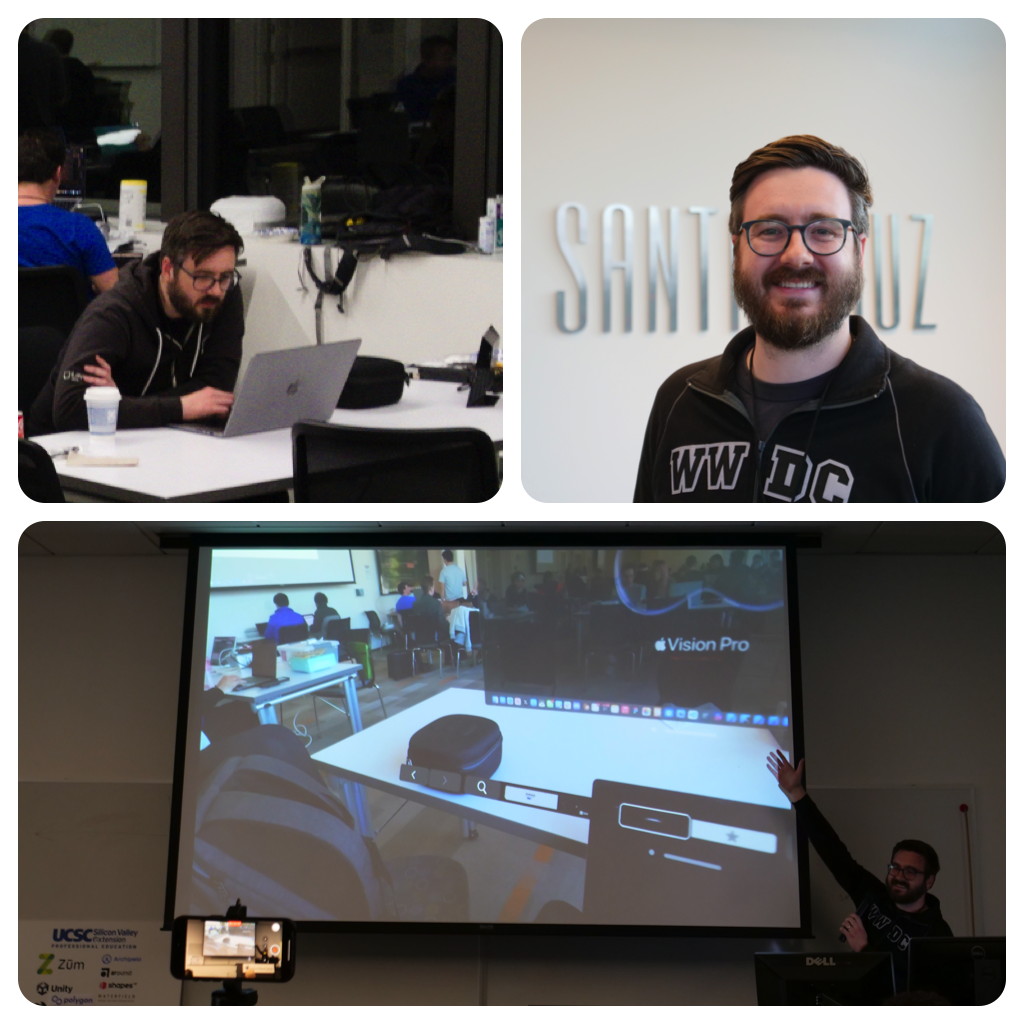
Zac White is a man with so much talent and vision he is actually ahead of his time. In truth he developed a project called ARKit at a prior event — before Apple even announced their framework.
So when Zac spent the weekend hacking, he didn’t just make something awesome. He also helped others by standing up a deployment network for others to use when pushing apps to their devices. But of course what he made is both beautiful and nostalgic: a complete replica of the MacBook TouchBar inside visionOS.
PinchBar does everything: controls, sliders, buttons, switches — and it reacts to gestures and direct manipulation. It completely works. Of course he made it Open Source. The man is a mensch. A one-man force. And we are grateful.
Best in Show
Camera Obscura

Of all the demonstrations at this event, there was one in particular that stood out as a mind-blowing technical and artistic achievement. Ina Yosun Chang recorded her magnificent contribution for us to show — because get this: she did it while fighting a Covid infection.
Thankfully she caught it in time to spare the rest of us, but she didn’t get to hear the awed reaction of our crowd during demo time. Her app lets you turn a photo into its own world by AI converting detected objects into 3D models.
“Upload your image and the server runs object detection and segments and processes the image for AI3D conversion. It will also generate several different artistic stylizations.
Then activate the AI3D light beam by heading over to the Oculus side of our AI3D Camera Obscura. Peer into the AI3D Oculus to check out the generated artistic stylizations of your image. She demonstrated a van Gogh style — totally cool.
Next, you can tap the AI3D Oculus button to fully enter the AI3D Camera Obscura — and tap the image to show the detected object completely segmented from the foreground. The built-in AI has attempts to fill in the removed object.
You can then press the AI3D Oculus button to go back to the external mode. You can repeat the process to create a cadre of detected objects. Tap each one to have it pop into the estimated z position, and to start the image-to-3D preview generation process. Pinch to move any of them.”
You could audibly hear jaws hitting the floor at demo time. Get well soon, Yosun because you must ship this!
Most Helpful
20 Tickets

The Grand Prize at our event goes to former champion and volunteer Dan Zeitman. At the end of our award ceremony, we ask everyone who helped another person with their project to please rise. We then start counting the tickets to see who helped the most times.
Dan was far and above the greatest recipient of praise as a mentor. This is our top honor, because helping others is what makes our community so special and creates a caring, authentically open vibe that cannot be faked. Dan has won this prize in the past, and he’s even helped to organize past events. He helped us with sponsors and brought attendees, he even picked up the tee-shirts this time. He’s a true hero and inspiration to us all.
Thanks, Dan! And thank you to all of our wonderful sponsors and community partners. This event was an intimate gathering of thoughtful, skillful and visionary entrepreneurs from all walks of life. We can’t wait to do it again soon!
